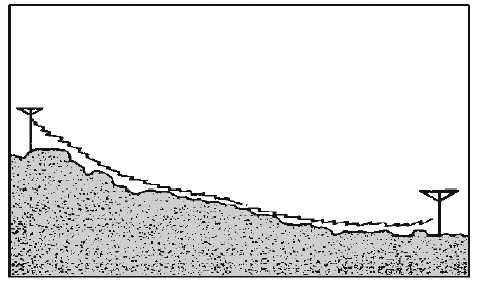2-16
Ground Waves
The ground wave is actually composed of two separate component waves. These are known as the
SURFACE WAVE and the SPACE WAVE (fig. 2-11). The determining factor in whether a ground wave
component is classified as a space wave or a surface wave is simple. A surface wave travels along the
surface of the Earth. A space wave travels over the surface.
SURFACE WAVE.—The surface wave reaches the receiving site by traveling along the surface of
the ground as shown in figure 2-12. A surface wave can follow the contours of the Earth because of the
process of diffraction. When a surface wave meets an object and the dimensions of the object do not
exceed its wavelength, the wave tends to curve or bend around the object. The smaller the object, the
more pronounced the diffractive action will be.
Figure 2-12.—Surface wave propagation.
As a surface wave passes over the ground, the wave induces a voltage in the Earth. The induced
voltage takes energy away from the surface wave, thereby weakening, or attenuating, the wave as it
moves away from the transmitting antenna. To reduce the attenuation, the amount of induced voltage
must be reduced. This is done by using vertically polarized waves that minimize the extent to which the
electric field of the wave is in contact with the Earth. When a surface wave is horizontally polarized, the
electric field of the wave is parallel with the surface of the Earth and, therefore, is constantly in contact
with it. The wave is then completely attenuated within a short distance from the transmitting site. On the
other hand, when the surface wave is vertically polarized, the electric field is vertical to the Earth and
merely dips into and out of the Earth's surface. For this reason, vertical polarization is vastly superior to
horizontal polarization for surface wave propagation.
The attenuation that a surface wave undergoes because of induced voltage also depends on the
electrical properties of the terrain over which the wave travels. The best type of surface is one that has
good electrical conductivity. The better the conductivity, the less the attenuation. Table 2-2 gives the
relative conductivity of various surfaces of the Earth.

